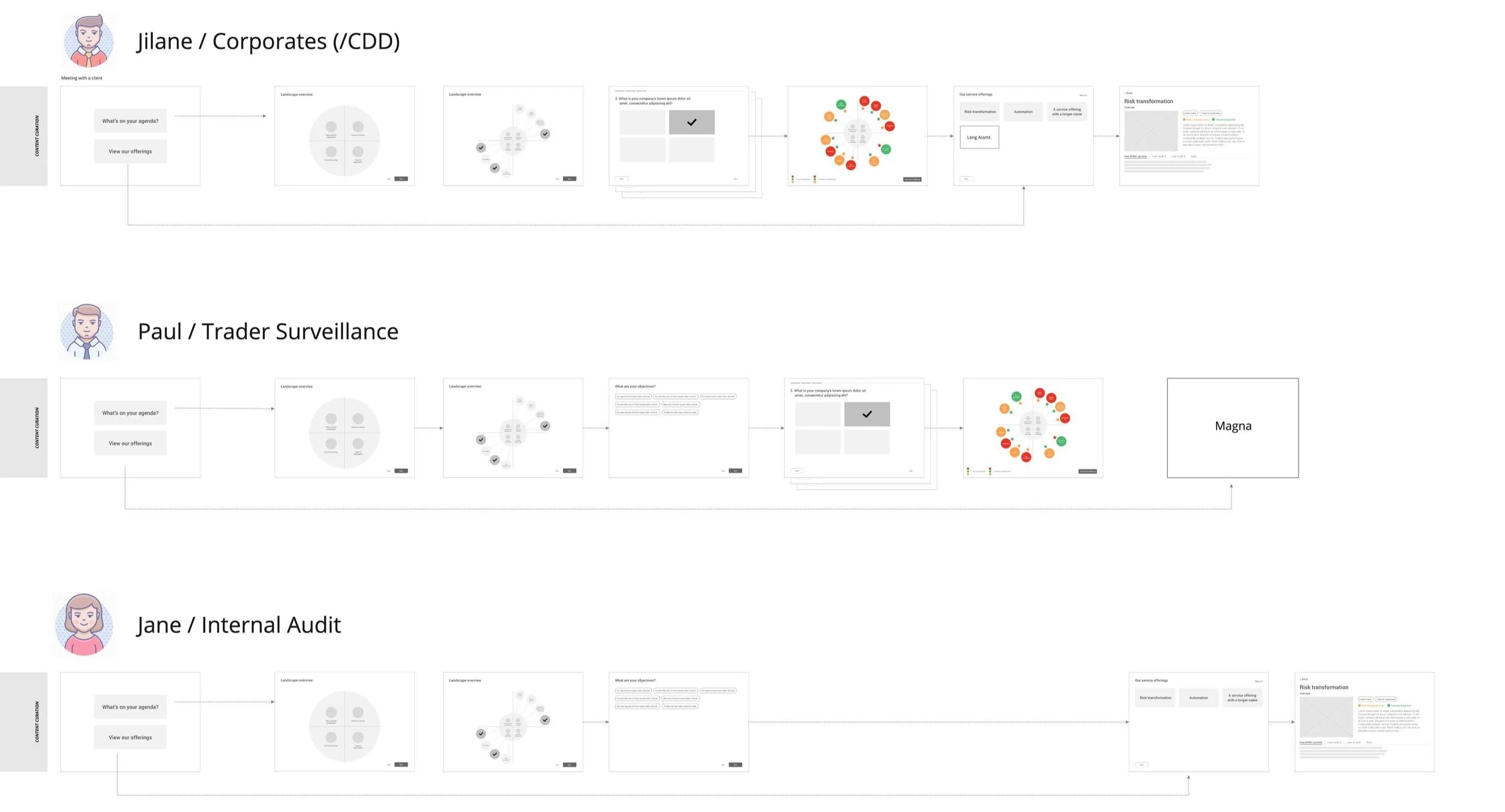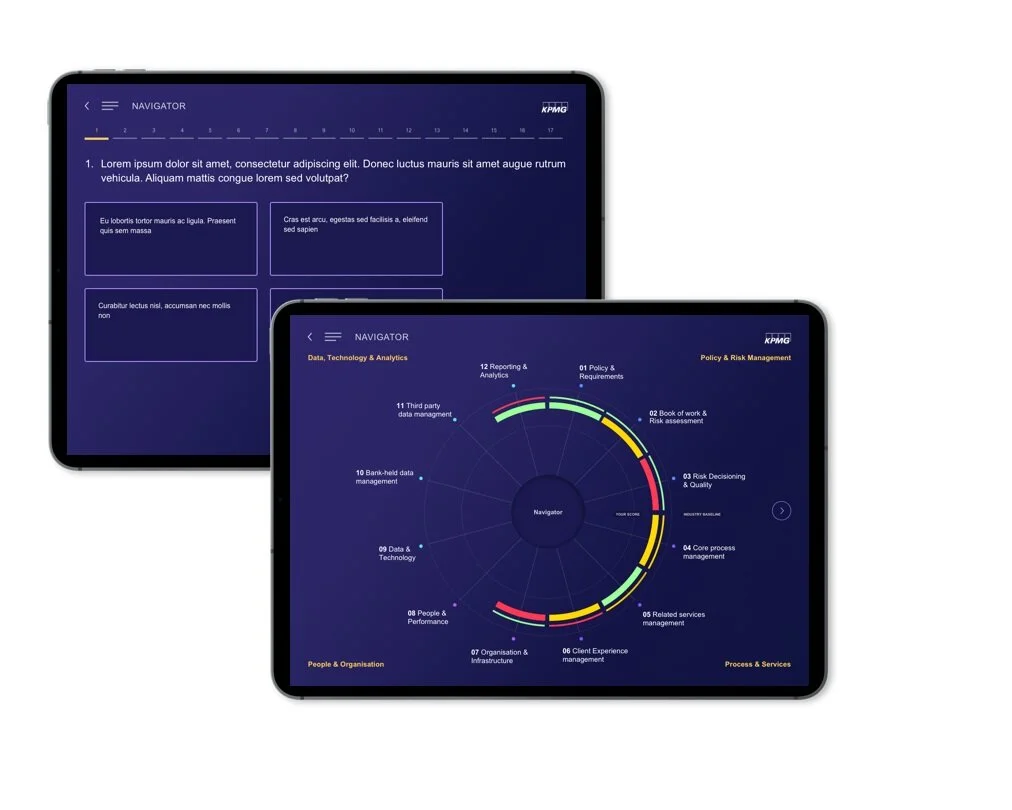Global Navigator
helping clients navigate business landscape
KPMG always strives to understand the core of the client’s pain, and to help alleviate those with our services. However, while some clients come to KPMG with a specific problem in mind, some clients struggle to understand where they need the most support.
KPMG Global has designed a sales enablement solution that can help the Advisory team understand their client on a deeper level and provide more meaningful services, by allowing them to publish and manage KPMG Knowledge & Capabilities content.
Global Navigator supports partners and directors to lead seamless conversations on KPMG’s strategy and service offerings with their clients.
The tool enables our partners and directors to effectively navigate industry landscape, capture a client’s maturity level, and provide curated service offerings.
Additionally, Global Navigator enables firms across the world to collaborate and gain shared insights to deliver global content for our customers.
Prototype - for better experience, extend the prototype by clicking top right of it
Project context
Challenge
To design a sales enablement tool that enables personalised content for the client
The Current Navigator, which is based on a PPT, was originally used to run a maturity assessment over a couple of hours. The project owners found out that most of the teams were not utilising the Navigator as is, and wanted an updated version. Our mission was to understand why the tool itself was not being utilised and design a new version of the Navigator for the partners.
Approach
Multidisciplinary agile team, user research, stakeholder workshops, prototyping
Global Navigator was designed through a highly collaborative and co-creational process. Partnering up with KPMG ITS Bulgaria, experience designers led a series of workshops that allowed the team to understand the problem in greater depth, define the new experiences, design an end-to-end vision of the digital service, and create a prototype to demonstrate potential functionality of the tool. The tool was showcased to five teams (Customer Due Diligence, Trader Surveillance, Internal Audit, Banking Fraud, Corporate) and the project owner, receiving great feedback and leading to a build phase.
User Research
This was a 6 week discovery project where we framed the problems, identified opportunities, created a strategy and prototyped concepts to unlock the potential of building out the solution. The first 3 weeks were used for user research, in which we had 5 As-Is sessions and 5 To-Be sessions with the key stakeholders.
Once we had held the workshops to identify opportunities, we started digitising the process and synthesising the information we collected. Some of the key pains as to why the partners were not using the Navigator were:
The Navigator had a lengthy questionnaire which took most of a day, while the clients only had 1-2 hours to have the meeting.
It was lacking a storytelling element, that would build up the conversation.
The PPT format was outdated and doesn’t have a modern look and feel, and also did not showcase KPMG’s ability in technology. As a result KPMG brand perception suffers and it is harder to make the sale.
Even when the partners did use the Navigator for the questionnaires, they had to find case study examples on their laptop. Finding relevant case studies across multiple member firms is stressful and time consuming.
The clients were interested in benchmarking and understanding their maturity level, but the Navigator did not provide that.
From there, we were able to identify the need for a digital sales enablement/conversation starter tool, that can support:
Methodology overview
Every conversation needs a conversation starter. Teams need an engaging and interactive way to present their respective methodologies.
Industry baseline
Any specific score is meaningless if there is no frame of reference. Global surveys and expert SME knowledge of KPMG employees can be used to inform the tool.
Short questionnaire
Quickly identifying a problem that exists in the client company is critical and the best way to identify it is to conduct a short questionnaire. In some instances the client should be able to do it online.
Curated content
Once the problem areas are identified, teams need the opportunity to pull out relevant service offerings and case studies to make a sale.
Ideation
We then mapped out the user flow and created wireframes to have a validation session with the project owners.
The main flow was that the tool would have visualisation of the industry landscape to help get the conversation started, then seamlessly lead to a short questionnaire that can provide the client with a maturity level. Afterwards, based on the questionnaire result, the tool would curate service offerings and case studies for review.
Visual designs
To begin our visual design process, we created a mood board of different designs that we can get inspired from. The elements on the mood board were on the colours, interactions, contents and interface design.
We then went through several iteration of the designs. The industry landscape page was particularly challenging, as it needed to represent the sectors, the maturity level of the client, as well as the industry.
Final Designs
Methodology ; Landscape Overview
The guided flow starts with an overview of methodology. Users are presented with the four initial quadrants and underlying sections with an ability to mark sections for later discussion or explore it in more detail.
Value: Setting the scene is extremely important. Every team we spoke to expressed a desire to start with their methodology: 4 initial quadrants and underlying sections.
Maturity Assessment
Once the scene is set the client is invited to answer a few questions that would help the tool to assess the maturity.
Value:
Assessing the current client situation was highlighted as a critical step of engaging a new client. The questionnaire allows the client to talk about their current situation and needs.
It creates a necessary segue to discussing how the client fares versus competition and what the possible remediation options might be.
Industry baseline comparison
A RAG status is assigned across subsections and are compared to an industry baseline defined by KPMG SMEs ahead of time.
Value:
Able to compare client scores to an industry baseline
This was highlighted as something essential to spark the conversation and create a foundation for a future sale.
Being below the industry baseline means a client could be falling behind when it comes to regulations and showing this comparison creates an urge to act.
Service offering and case study
Based on the areas that were marked as red or amber the tool suggests relevant KPMG service offerings which could help to remediate the situation. Case studies associated with the offerings are presented as well based on the client industry and geography.
Value:
Service offerings, materials and case studies can be centralised and accessed digitally.
Presenting relevant bits of information depending on the client situation;
Presenting information in a visually appealing impactful way;












